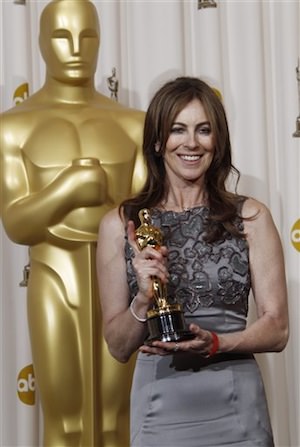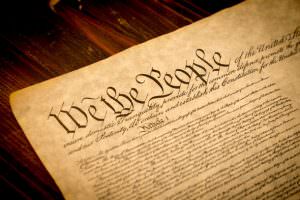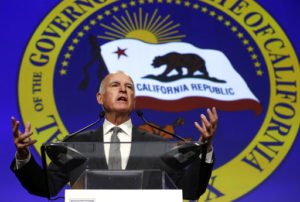Hollywood Isn’t So Progressive When It Comes to Female Filmmakers
When Kathryn Bigelow won an Oscar for 2008's "The Hurt Locker," it was widely viewed as a breakthrough moment for women who worked behind the camera. But several years later, Bigelow is still an exception to the long-held belief in Hollywood that a man must steer a film in order for it to have a chance at financial success. A new study reveals the extent of the gender gap behind the camera in the movie industry.
When director Kathryn Bigelow won an Oscar for 2008’s “The Hurt Locker” — becoming, in the process, the first woman to win an Academy Award for best director — it was widely viewed as a breakthrough moment for women who worked behind the camera. But several years later, Bigelow is still an exception to the long-held belief in Hollywood that a man must steer a film in order for it to have a chance at financial success.
Bigelow’s success aside, there’s no question that female filmmakers overall have made tremendous strides in the movie world recently. One only needs to look at the recently concluded Sundance Film Festival, where not only were half of the films in the dramatic competition made by women, but the winning movie in that category was directed by one.
Yet, according to a recently released study commissioned by the Sundance Institute and Women In Film Los Angeles and conducted through the USC Annenberg School for Communication and Journalism, most of the progress women behind the lens have made has been limited to independent films. And even in those, the report concludes, females still lag behind their male counterparts.
Among the study’s major revelations: Women have more success with projects outside of the big studios than with those made within that system; they are more likely to be associate producers than producers; and they are less likely to be hired for big-budget productions than for lower cost ones.
In other words, Hollywood, long viewed as a liberal and progressive place, is still mostly an old boys’ club.
The study looked at 820 narrative films and documentaries from the U.S. that were screened at Sundance between 2002 and 2012. It found that women made up 29.8 percent of the 11,197 directors, writers, producers, cinematographers and editors on those movies. Broken down further, women directed just under 24 percent of the films, and they were more likely to helm documentaries (34.5 percent) than narrative ones (16.9 percent).
Researchers also demonstrated that the gender gap, while still existing in independent movies, is far more pronounced in Hollywood studio productions: Just 4.4 percent of the top 100 films at the box office each year between 2002 and 2012 were directed by women.
The study’s authors — Annenberg professor Stacy L. Smith and researchers Katherine Pieper and Marc Choueiti — concluded that women are more vulnerable to the “external pressure” of narrative filmmaking than to documentary production because “as they work with larger budgets, the pipeline between independent film and the studio world narrows to allow few females to push through.”
Essentially then, the more one factors in money — something typically associated with major studio films — the more women behind the camera are excluded.
“Our qualitative study points to some of the reasons why females are not being attached to films with larger budgets,” Smith told Truthdig. “While financing is often a barrier in film, a full 43.1 percent of the participants we interviewed indicated that perceptions regarding females and finance affect securing the resources needed for a green light. For instance, our study respondents indicated that females are perceived to be less trustworthy or confident with financial resources than males and female driven content is viewed as less commercially viable.”
Another reason female filmmakers are at a disadvantage, Smith said, is because most of Hollywood’s financiers are men. “These factors, in isolation or combination, put female filmmakers at a disadvantage when it comes to being attached to cinematic properties,” she said.
Hollywood clearly has a bias that largely favors men and the way their narrative storytelling is focused. “The vast majority of films made and seen in the United States are written, directed and produced by male filmmakers whose stories tend to reflect dominant themes and reinforce the status quo,” the study’s case statement argues.
According to Smith, “Audiences are being socialized to view most stories and perspectives through a male lens. Such a viewpoint is at odds with the moviegoing audience, half of which are female, the gender composition in the U.S. and the buying power of females in this country.”
That leads to one of the questions posited in the case statement: “What might the future look like for both men and women given the full inclusion of a generation or two of truly empowered female perspectives in our media ecology?”
We know that it would look differently because empirical evidence shows that gender can “affect the types of stories being told” and “impact the very nature of a story,” according to the study. Moreover, female directors are more likely to feature women and girls in their movies than male directors, something that can have a major impact on younger audiences that “often see on screen girls and women in motion pictures relegated to secondary, stereotyped and/or sexualized characters,” Smith said.
“By diversifying the gender of content creators, the prevalence and nature of girls and women on screen changes,” she added. “This is what I have found in my own lab and other researchers have documented such changes as well.”
Another positive trend that emerges from having women at the helm of a film is that it increases the odds that other females will work in positions behind the lens, ensuring a more “gender-balanced” crew. The research demonstrates that the percentage of women working on a film increases — 21 percent in narrative films and 24 percent in documentaries — when a female is in a leadership role.
“That women seem to be supporting and giving opportunities to other women behind the camera” was one of the positive results the study found, Smith explained. The other, she said, is the opportunity afforded to women by the Sundance Institute itself.
“A full 43 percent of the fellows attending their labs, conferences or summits over the last 11 years in the feature film program or the documentary film program were female,” Smith noted, adding that “41.5 percent of all female directors helming top grossing films between 2002 and 2012 have been supported by the Sundance Institute at some point in time during their careers.”
The recent success of female filmmakers at Sundance undoubtedly is a sign of progress. But make no mistake — Hollywood, long viewed as a bastion of political liberalism and progressiveness — still has a long way to go in terms of gender equality behind the scenes.
Until that happens, directors such as Bigelow will continue to be the exception, rather than the norm.
Your support matters…Independent journalism is under threat and overshadowed by heavily funded mainstream media.
You can help level the playing field. Become a member.
Your tax-deductible contribution keeps us digging beneath the headlines to give you thought-provoking, investigative reporting and analysis that unearths what's really happening- without compromise.
Give today to support our courageous, independent journalists.





You need to be a supporter to comment.
There are currently no responses to this article.
Be the first to respond.